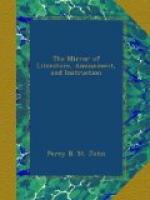Whether the French were first indebted to the Roman school for their knowledge of the art of painting is a matter of some doubt; indeed, several celebrated French writers affirm, that they first had recourse to the Florentine and Lombard schools; while others very strenuously declare, on the other hand, that the Venetian artists were alone resorted to, on account of the remarkable splendour of their colouring. A late author, however, observes, that the French do not appear to have imitated any school whatever, but to have adopted a style peculiar to themselves, which though perhaps not a noble one, is nevertheless pleasing. Though it is acknowledged that the French have a particular style, (i.e. a style of their own,) yet their progress in the arts has been exceedingly fluctuating and uncertain, so that it is actually impossible to ascertain who was the first reputable artist amongst them. Cousin was a painter on glass, and certainly obtained a good reputation amongst his countrymen. But he in fact possessed very little merit, and his name would not doubtless have been known to posterity had he not lived in a barbarous age, when the people knew not how to discriminate his errors and defects. He was supposed to be the best artist of his day, and consequently gained a reputation as such, though his works are far beneath mediocrity.
Francis I. was a great encourager of the fine arts, and the artists themselves were liberally paid for their productions, until that king was unfortunately taken prisoner at the battle of Pavia, in the year 1525. After the death of Francis, the kingdom was distracted with civil wars, so that painting was entirely neglected by his immediate successors. In the year 1610, however, Louis XIII. recovered the arts from their languid state. In his reign, Jaques Blanchard was the most flourishing painter; although Francis Perier, Simon Voueet, C.A. Du Fresnoy, and Peter Mignard, were equally gifted.
Of Charles Alphonse Du Fresnoy, author of a Latin poem, entitled De Arte Graphica, I shall attempt a little account. This painter was born at Paris in the year 1611. His father, intending him for the profession of physic, sent him to the university of Paris, where he made great progress in his studies, and obtained several prizes in poetry. He had a great inclination for painting as well as for poetry, and, though much against his father’s desire, resolved to leave off the study of physic, and commence that of drawing. The force of his inclination subduing every measure adopted to suppress it, he took every opportunity of cultivating his favourite study. Leaving college, he placed himself under Francis Perier, from whom he learned the art of designing. He afterwards thought fit to travel into Italy, where he arrived in 1633. Being abandoned by his parents, who were highly incensed at his having rejected the study of physic, he was reduced to the utmost distress on his arrival at Rome, and was compelled to paint




